

Current research has uncovered that the Endocannabinoid System (ECS) is a sophisticated group of neuromodulators, which are receptors, and signaling pathways involved in regulating a range of functions and process of physiological processes including movement, mood, memory, appetite, sleep, pain, reproduction and fertility that can be found throughout the body. It is ultimately responsible for maintaining biochemical and physiological balance.
Medical Cannabis and Hemp-derived CBD interacts with a patient’s biology in a way that is nearly identical to the natural process of human biology, through the endocannabinoid system. The ECS is a complex cell-signaling system identified in the early 1990s by researchers exploring THC, a well-known cannabinoid. The other primary cannabinoid found in Cannabis is CBD. Unlike THC, CBD doesn’t make you “high” and typically doesn’t cause any adverse effects. Cannabinoids, as complex chemical compounds, act on receptors in cells within the human body. The human body naturally produces cannabinoids (endocannabinoids). In addition, medical Cannabis and Hemp-derived CBD produce over 113 different cannabinoids (Phyto cannabinoids) that nearly mimic naturally occurring endocannabinoids produced in the human body. Cannabinoids influence this balance by interacting with cannabinoid receptors to regulate natural homeostasis via the ECS.
When a patient is suffering from certain illnesses, the interaction of cannabinoids (medical Cannabis and Hemp-derived CBD) with specific receptors in the patient’s ECS may diminish negative symptoms and expedite healing, without the adverse effects or contraindications of current pharmaceuticals.
The ECS involves three core components: endocannabinoids, receptors, and enzymes.
Endocannabinoids, also called endogenous cannabinoids, are molecules made by the body. They’re like cannabinoids, but the human body naturally produces them.
Experts have identified two key endocannabinoids so far:
Endocannabinoids keep internal functions running smoothly and are produced as needed, making it difficult to know what typical levels are for each.
These receptors are found throughout your body. Endocannabinoids bind to them to signal that the ECS needs to act.
There are two primary endocannabinoid receptors:
The effects that result depend on where the receptor is located and which endocannabinoid it binds to, based upon the formulation of the cannabinoid compounds.
Endocannabinoids can bind to either receptor (CB1 or CB2).
If an endocannabinoid binds to CB1 receptors in a spinal nerve, it may relieve pain, reduce swelling, or an alternative outcome, based upon the formulation of the influencing cannabinoid compound.
Another endocannabinoid might bind to a CB2 receptor in your immune cells to signal that your body’s experiencing inflammation, a common sign of autoimmune disorders.
Once the endocannabinoids unbind from the receptor, Enzymes will break down the endocannabinoids once they’ve carried out their function.
There are two primary enzymes responsible for this: